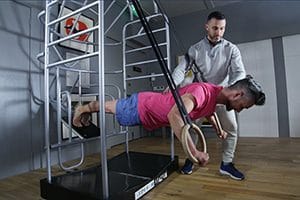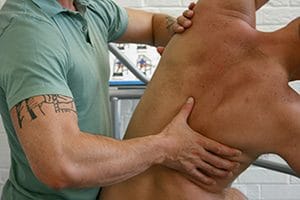AFS or Applied Functional Science is a system of analysing how a person’s posture and movement may deviate from the ideal pattern. Using a variety of manual and exercise techniques, it can then restore optimal movement and function.
AFS was developed by the American physiotherapist Gary Gray, who is famous for his work with Tiger Woods, and it’s sometime referred to as Functional Biomechanics.
AFS is great for treating sports related injuries. It works well alongside osteopathy and vibration training
The Principles of Applied Functional Science in the Notting Hill Studio

The key principle of this technique is that any test, treatment or exercise should replicate natural function.
Gray worked extensively with David Tiberio, a renowned Doctor of Physiotherapy. One of their main areas of interest and study was the foot. They taught workshops to physios and other therapist about the type of limb mechanics studied by podiatrists.
They were pioneers, as few manual therapists paid much attention to foot mechanics with such specificity and detail.
Another key principle of AFS is that the action of a muscle when the foot is off the floor is dramatically different form when the foot is on the floor. For example, the shin muscle can pull your toes towards the ceiling, but in walking it actually stops the front of your foot crashing into the floor when your heel strikes the floor.
Building upon this early work the two doctors collaborated on a system that observed the way a body moves in everyday activities and devised ways to cleverly correct faulty movements and encourage healthy ones.
For example, a patient with a throwing injury will be assessed in an upright position. The therapist will observe what is happening at a series of joints as the patient performs throwing-like movements. When you wind up to throw a ball you need to load the muscles of the hip and trunk. There may be too much or too little movement occurring at one or more body segments. The therapist may touch the joints to feel if the direction or the movement is correct. From this, the therapist can work out why some tissues are being over-stressed. The therapist can then mobilise the stiff segments and stabilise the segment that is too flexible through a combination of manual therapy and exercise.
This sounds like traditional physiotherapy, but with AFS there are some key differences.
Applied Functional Science versus Physiotherapy
The treatment and exercises must replicate the action, i.e. the relationship of all the joints and muscles must remain the same as the actual activity.
If we continue with the example of throwing a ball, the abdominal oblique muscles need to be strong enough to safely control the wind up and generate enough force to propel the ball. Sit ups would never be used in this case. The abdominal exercises would be performed in a standing position, with the body leaning back and twisting to replicate the movement.
The hip muscles must also be pre-loaded as they would be when preparing to throw.

If a patient becomes strong at sit-ups, the skill is not transferable. What this means is that when a patient does sit-ups the brain and joint receptors do not get a chance to practice or correct the throwing movement pattern. The new strength is not specific to throwing.
Even if the patient has become stronger, they are not likely to have improved their performance within the range specific to throwing and certainly not at the types of speeds required for that activity.
Rhythm and speed are very important when tweaking or adapting an AFS treatment or exercise. The therapist might ask a patient to perform a high-speed movement that replicates throwing and guide the patient’s movement at the critical moment.
In addition, the therapist may ask the patient to vary their speed or add a load like a weight or elastic band.
Applied Functional Science equipment in the Notting Hill Studio

One very useful bit of equipment in the AFS arsenal is the Truestretch (which is installed in our Notting Hill Studio). This is a cage with angled surfaces and bars. It allows the therapist to place the patient in any position while maintaining four points of contact – i.e. both hands and both feet. This means that the patient can effectively stretch any muscle in all three directions/dimensions and the therapist can mobilise a target joint or guide the patient’s movements in an effective, controlled and safe way.
The angled surfaces allow the practitioner to change the influence on the joints of the feet. AFS is a powerful and effective tool that can vastly improve treatment outcomes.
